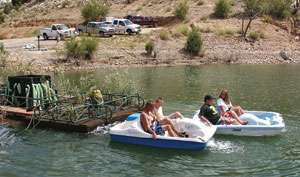
ALBUQUERQUE, N.M. — The New Mexico BASS Federation Nation (NMBFN) is advancing research that could result in bass fisheries becoming more self-sustaining in reservoirs characterized by extreme water fluctuations.
With expertise from Floating Islands West and Floating Islands International , cooperation from the city of Albuquerque, and assistance from the Kids of the Southwest Junior bass club, prototype suspending spawning platforms have been placed in Elephant Butte Reservoir and in a lake at Tingley Beach. The intent is to provide stable spawning and nursery environments that are immune to the devastating effects of drawdowns.
“Like most Western states, the water levels in our reservoirs fluctuate rapidly, especially during the spawning season when water is flowing in rapidly from mountain runoff and flowing out for crop irrigation,” said Earl Conway, conservation director for the NMBFN. “As a result, we often lose most of our natural spawn.
“During severe drought, we often lack cover for the fry, so even if we have a spawn, their survival is minimal. We have been searching for a way to help nature by creating habitat the provides all of the elements needed to promote bass spawning and recruitment.”
The conservation director explained that the structures will be used to experiment with bed media, plants, water depth and other variables “to provide an optimum combination that attracts gamefish, encourages spawning activities and supports rapid fry growth and survival.”
Although the study is in its infancy, he added that much has been learned about deployment, plant survival and attrition in extreme summer heat, as well as anchor strategies for fluctuations.
“One unexpected challenge is keeping pea-size gravel in the nests,” he said. “It appears that catfish and other fish have no problem emptying the gravel out of the nest.”
The project began when Conway contacted Bruce Kania, inventor of the platforms, who agreed to partner with the NMBFN. On June 29, one of the platforms was placed in Elephant Butte.
“The platform is a superbly engineered research platform that represents a substantial investment from Floating Islands West,” Conway said.
Kids of the Southwest helped with the launch and have adopted the project. They are monitoring the island above the floating spawning bed and will add additional plants and seeds as needed.
“The current focus is on experimenting with plants that will provide a complex root structure under the islands [and above the spawning platforms] to provide the bass fry a safe nursery until they are big enough to move to the shore,” the conservation director added.
“Next year, we will move the platform to a strategic location and observe spawning activities and the progress of resulting fry.”
Finding the right combination of elements to make the platforms effective is especially important for New Mexico, which does not yet have a warmwater hatchery that can raise bass from eggs, Conway said.
“Fry and fingerlings must be bought or bartered from other states, and supply has been an issue in past years. As a result, the bass populations and angling opportunities have risen and fallen with lake levels.”
Bass reproduction from these suspended platforms under floating islands of plants never will replace successful natural spawns, he added, but hopes are high that they will increase recruitment to avoid complete failure of year classes, as sometimes happens now.

